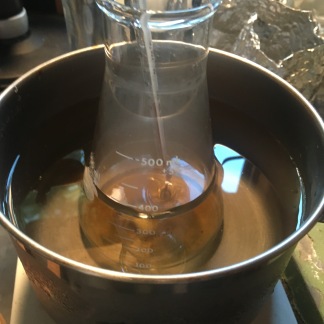I didn’t have much time to do chemistry on spring break, unfortunately, but I did get to make some anthranilic acid based on ChemPlayer’s video. I followed the video procedure almost exactly.
Procedure
About 20 grams of sodium hydroxide (from drain cleaner) is added to 100 mL of ice water in a 500 mL wide-mouthed Erlenmeyer flask containing a magnetic stir bar. The solution is stirred moderately until all of the sodium hydroxide dissolves.
30.00 grams of phthalimide is added to the NaOH solution. The phthalimide should be added relatively quickly. In this step, the phthalimide is deprotonated to yield sodium phthalimide and water.
An ice bath is placed around the flask, and stirring is continued, as 157 mL of 10% sodium hypochlorite is added to the solution all at once. Stirring is continued for 15 minutes, and then the ice bath is removed (the ice bath is actually unnecessary).

After the hypochlorite is added, the solution becomes a faint yellow color, and some bubbles of carbon dioxide are produced. Bubbling proceeds more rapidly as the solution is heated to 75ºC and maintained there for 15 minutes, which insures the destruction of the isocyanate intermediate.
The solution is then cooled in an ice bath to about 10ºC and about 30 mL of it is set aside in a small beaker. Cautiously, 31% hydrochloric acid is added to the solution with vigorous stirring, accompanied by the evolution of a considerable amount of carbon dioxide. pH of the solution is tested using universal indicator paper after every 1-2 mL of acid is added. Once it appears to be very slightly acidic, the reserved 30 mL of solution is added to the flask, making the solution alkaline once again. Then, 31% hydrochloric acid is added dropwise with thorough pH testing every few drops until the pH is almost exactly neutral. At this point, about 0.5 mL of the solution was transferred to a test tube and a liquid universal indicator was used to double check the pH.
30 mL of glacial acetic acid was then added slowly to the flask with vigorous stirring. A tan precipitate of anthranilic acid forms, and the mixture becomes very frothy. Care must be taken to add the acetic acid slowly so that it doesn’t foam over. Transferring the solution to a larger vessel, such as a 1 or 2 liter beaker is recommended, but I did not have one available.
After all of the acetic acid has been added, vacuum filtration is used to collect the precipitate. The precipitate is then washed with two 50 mL portions of cool water, and allowed to stay on the vacuum until it is reasonably dry.
The anthranilic acid is transferred to an evaporating dish and heated on a hotplate for an hour at 100ºC, with lumps being broken up periodically.
Results/Discussion
Yield of anthranilic acid was 13.05 grams, which represents a 46% yield based on phthalimide. Although this is rather low, it is not unexpected, as Hofmann rearrangements tend to be low yielding, and ChemPlayer’s yield was only 44%.
Some of the anthranilic acid will be used to make methyl anthranilate, the ester used commonly as artificial grape flavor, and the rest will be saved for other future experiments, which could include following ChemPlayer’s other videos, or possibly using it as a source of benzyne for an aromatic Diels-Alder reaction should I be able to find a suitable diene.






why do we have to add the acetic acid? what role does it play in the synthesis?
LikeLike
Somehow I missed this comment until a year and a half later. Sorry about that. The acetic acid is added to reduce the solubility of the anthranilic acid, causing it to crystallize out of solution. If a stronger acid, such as HCl, was used instead, it would protonate the amine, causing the compound to become more water soluble. Acetic acid is a good choice because it can protonate the carboxylate, but not the amine.
LikeLike